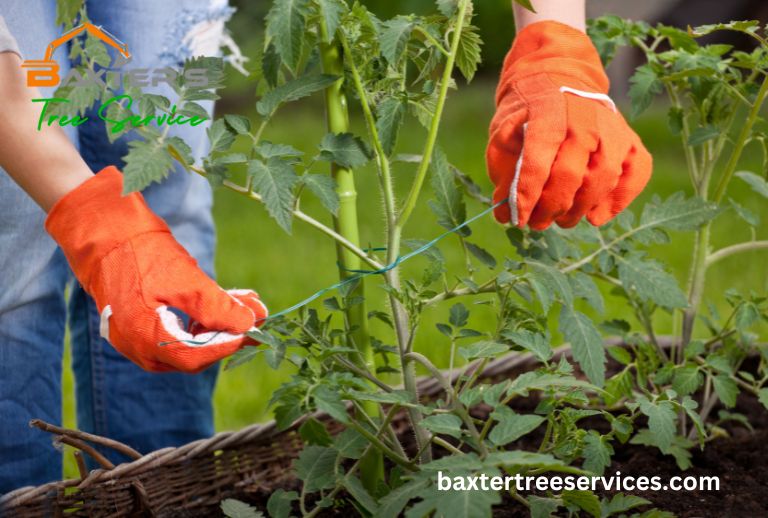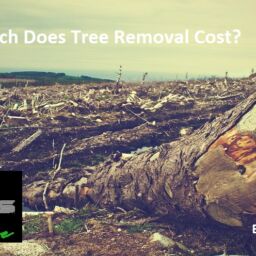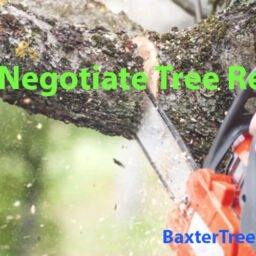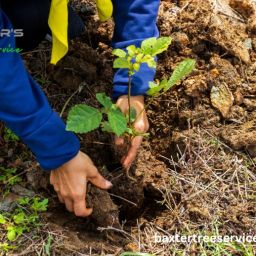


Staking is a common practice used to support and protect recently planted trees. It takes one full year for a tree to stabilize and grow independently. After this period, stakes should be removed; otherwise, the tree’s growth will be hampered.
In this guide, we’ll understand the staking process and how to remove the stakes for promising growth.
What are Tree Stakes?
Tree stakes have gained popularity among homeowners in recent years. Anyone concerned about the newly planted trees can benefit from good-quality tree stakes. Why do we need a stake?
A young tree doesn’t have enough stability to stay grounded and withstand harsh weather and blustering winds. In such a scenario, easy-to-install stakes rescue the innocent saplings growing in your garden.
Are you interested in hiring tree removal services? Contact Baxter Excavation and receive a free estimate of our services after a detailed discussion.
When to Consider Removing Tree Stakes
The duration for which you should keep stakes depends on various conditions, including but not limited to soil conditions and weather. On the safer side, the stakes should remain for a minimum of one year (2-3 seasons) for the upright and healthy growth of the tree.
Normally, stakes are required for trees having thick foliage, more petite root balls than overall size, or due to windy weather. A duration of one year lets the roots settle correctly and gives the tree enough time to grow ideally. However, if the stakes remain beyond this time frame, tree growth may hurt.
Signs When to Remove Tree Stakes
Stakes should not remain attached to the tree for more than a year. But how would you be sure when the right time to remove the stakes is? The answer is simple. There are a few signs that indicate the safety of steaks removal. Let’s have a look at them one by one:
- Season
- Roots strength
- Trunk
Season
It is important to note that the trees’ stakes should be removed in the fall season, whether they were planted in the spring season or the previous fall season.
Roots Strength
If the tree roots wiggle upon hitting the trunk, it is a sign that the tree is not ready to stand on its own. The root system needs more time to settle firmly into the soil.
Trunk Condition
If the trunk sways or bends downward, it is a sign that the tree should be staked for another season to develop fully.
How to Safely Remove Tree Stakes
Stakes should be removed carefully to avoid damaging the tree. Inspecting stakes once a month for signs like nearby insect colonies would be best. Poorly installed tree stakes affect the growth negatively. Look for signs like epicormic growth, exposed roots, and discolored leaves to understand its time for stake removal.
Furthermore, the soil condition should be considered before deciding to uproot stakes. Highly alkaline or acidic soil weakens the tree stake in the long run. Get the soil tested by an expert to know its condition and take necessary measures to balance its chemical ratio.
Mentioned below are the four steps you should take to remove the stakes properly:
-
Step 1
The first step involved measuring the tree trunks. Use a measuring tape to measure the trunk’s diameter and the tree’s total height. Determine the tree trunk’s diameter and the tree’s overall height.
Removing tree stakes is a safe bet if the tree is approximately six feet tall and the trunk is one inch in diameter. However, it is not a fixed rule and varies for each species.
-
Step 2
Exercise caution while removing the guy wires as it may damage the bark if done carelessly.
-
Step 3
The third step involves hitting the stake near its base to loosen it up. Then, moving it back and forth will further weaken it. Done correctly, you should be able to pull it upwards.
-
Step 4
Don’t forget to fill the stake hole with loose soil.
Common Mistakes to Avoid
Look at some of the mistakes below to avoid them while installing and uprooting tree stakes.
-
Using stakes unnecessarily
Staking is only required when the tree is fragile enough not to withstand harsh weather conditions. Sometimes, trees are staked when they don’t need support, hindering natural development. It’s crucial to assess the tree’s stability before deciding to stake it.
-
Tying too tightly, causing damage
Overly tight ties can constrict a tree’s growth and damage its bark. Use materials that allow for some flexibility. Then, you should periodically check and adjust the tie tension if needed.
-
Ignoring tree growth leads to constriction
Stakes left too long can hinder trunk development and cause girdling. This will inhibit the nutrient flow, resulting in damaged bark and discolored leaves. Monitoring the tree’s progress and removing stakes on time is essential for satisfactory growth.
Consequences of Leaving Stakes Too Long
Prolonged staying stakes have detrimental effects on the tree’s health. A common repercussion is restricted trunk growth. Trees become reliant on the stakes, hampering their natural development. Additionally, the ties used to keep stakes around the tree can result in girdling, making the tree susceptible to diseases. Girdling due to staking also inhibits nutrient flow within the tree body.
FAQs
When Should You Remove Tree Supports?
Tree supports should be removed after two to three seasons, typically a complete year of time. Ensure that the tree is sufficiently established to support itself. Leaving stakes or ties too long can hinder natural trunk development and cause damage. Regularly monitor the tree’s stability and remove supports gradually to encourage healthy growth and prevent dependence.
Do Stakes Help Plants Grow?
Yes, stakes help plants grow. They provide support for young newly planted trees, helping them grow upright and reducing the risk of damage from wind or other environmental factors. However, removing stakes once the plant is strong enough to support itself to avoid stunting growth or causing damage is crucial.
How Long Should You Leave Stakes Around a Tree After Planting?
Stakes should remain around a newly planted tree for about one to two years, depending on its growth rate and stability. It’s essential to regularly assess the tree’s development and remove the stakes once it can support itself to prevent stunted growth and trunk damage.
Ready for Expert Tree Removal services?
Looking for expert help with tree staking and maintenance? Turn to Baxter Tree Removal Services for personalized assistance unique to your needs. We take extreme care in treating your garden as it can directly impact the tree’s longevity and health. We ensure your trees receive the care they deserve.
Don’t leave your trees to chance. Contact Baxter Tree Services today to schedule a consultation and take the first step toward maintaining vibrant, thriving trees on your property.









